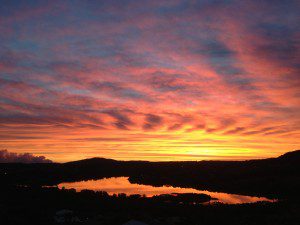30th April 2014
By Andy Whitley
Contributing Writer for Wake Up World
Warning: Aboriginal and Torres Strait Islander readers are warned that this article contains images of deceased persons.
On Wednesday 23rd April, our friend and Original guide Auntie Beve passed away at age 79. Auntie Beve was like family to many of us. Her beautiful smile, sharp tongue and comforting presence is already dearly missed. But beyond the emotional loss of our wise and caring friend, the effect of her passing is as significant as her life was full.
Auntie Beve was the last fully initiated woman Elder of the Darkinoong tribe, and bore the scars to prove it. Sadly, her passing marks the ceremonial end of her ancient tribal ancestry. The culture that thrived in this land for so many thousands of years has passed with her, leaving no living female initiates of the Darkinoong blood line.
But Auntie Beve certainly left a legacy. Deeply connected to the Old Ways of the Original people, she was also known by her tribal name ‘Goolabeen’, meaning “wise woman who collects knowledge and passes it on”. She was a story teller and a true teacher, who taught us traditional stories, the Dreaming, bush medicine, and tribal lore. Most importantly, she reminded us to always – always – fight for what is right, and to never let superficial differences get in the way of the big picture.
Please note: As she has now rejoined her ancestors, it is in keeping with Original protocol that we do not speak her full name aloud.
White Fella, Black Fella
Auntie Beve was born in Woy Woy NSW in 1935 of mixed Aboriginal/European heritage. As a baby she was taken from her mother by her white grandmother, who thought her mother was too young and inexperienced for motherhood, and was raised unaware of her Original roots. At 16 she became a ballet prodigy, dancing for what later became the Australian Ballet company. Then at 23 she “married a farmer, and so my story continues”…. a story that includes the role of proud mother and grandmother, a role she cherished until her last days.
Very sharp minded, Auntie Beve’s education was very diverse. As she recently described:
I went to University of Technology Sydney (UTS) at 48 years of age to get that white man’s ‘piece of paper’ to continue to teach. I ended up with quite a few of them in the end. I gained an Associates Diploma of Adult Education, a Bachelor of Aboriginal Adult Education, a Graduate Diploma of Adult Education, a 4th Year Health Worker degree from the First Aboriginal Uni at La Perouse… Before that I had an Advanced Diploma of Dance, a Graduate Diploma of Permaculture in Environmental Studies and Advanced Landscape design from Bill Mollison (Permaculture Institute Tasmania and Australia).
Her career was as colourful as her clothing. Her professional life included time as a ballerina, teaching shanti yoga and tai chi, permaculture, working with people with disabilities, working with street kids and signing for the deaf. But the role that she regarded most proudly was the 29 years she spent working in the prison system…
… as a suicide counsellor really, but classed as a Mental Health Worker, Aboriginal history, Culture and Art Teacher and tutor also. I later joined Justice Health, writing Health and Culture programs that ran in Corrective Services facilities all over New South Wales. I acted as a welfare person when one wasn’t available. Before that I worked as a Field Officer for ‘Aboriginal Deaths in Custody Watch Committee’ with Ray Jackson, a very fine and dedicated man who will die with that bone in his mouth. My hero for any injustice to our people, he is front-line mouthpiece for the constant struggle for Aboriginal Health and Justice.
Remarkably, it wasn’t until she was 40 years old that Auntie Beve learned that her father’s mother was a full-blood Aboriginal. Her grandmother died in 1936, a year after Beve was born, and at that time “half-cast” kids (as they were known) were often made to “assimilate”, and it was common to deny or conceal a child’s Original heritage if it wasn’t physically apparent. For that reason, Auntie Beve was not made aware of her own Original roots until much later — when a family friend bluntly revealed to her “your grandmother was a f***ing black fella”.
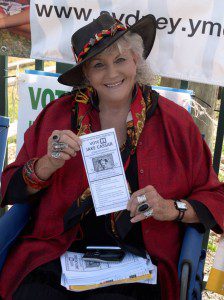
Of her grandmother, Auntie Beve recently said “my time with her was short lived. I often wonder what wonderful things I could have learned from her given the time”.
Undeterred, Auntie Beve explored the Original culture and spent years “runnin’ around the bush” learning the Old Ways, the stories, traditions, songs, ceremonies, lore and medicine of her land. But because the ranks of the Darkinoong had effectively been decimated, she found herself in a unique position; breaking with tradition, her initiations were conducted by Elders from another tribe as there were not enough Darkinoong Elders left to properly complete her initiation. She was also taught many of the stories normally only taught to Darkinoong men, in hopes she might pass them on.
Never bound to a single profession, tribe, race or gender limitation, Auntie Beve invariably walked the line between cultures; between prisoners and the prison system, and between black and white, and between Original tribes – and sometimes between a rock and a hard place. By nature, she was a guide, teacher and diplomat, always working to balance opposing forces.
In her own words…
I am a fully initiated law/lore and medicine woman and a Darkinoong Elder, and this is my Grandmother’s country, Darkinoong country.
My people were known as ‘short tails’ (fish people) who were from near the water. The ‘long tails’ (kangaroo people) were from the inland. Our boundaries being from the south side of the Hunter River to the north side of the Hawkesbury River from the Great Dividing Range and down to the sea, as told to me by the Elders.
I was properly initiated in the central deserts by three fully initiated law and medicine women from Utopia, Ammaroo and Kintore, which is the right way for this ceremony to happen (men need three fully initiated law men also). I was taken as family by Auntie Mary McNamara and Queenie, the head woman of the Alyawarra tribe from Utopia Way, Simpson Desert. I was initiated in 1985 by the head Law Woman, her name was Lena Pulla from Ammaroo. I had to go back each year and stay with them to learn more.
Later I was adopted by Norah Napaljarri Jurra, Nelson’s father (Banjo Tex from Nyrippi and Yuendumu from the Tanami Desert)… He gave me my skin name Napaljarri.
I regularly attended every law woman’s meeting held every year for 16 years, until I had a nasty accident in Tamworth Jail in 2007 in which I broke my shoulder and my knee, making it impossible for me to attend the very Sacred and Cultural meetings where we sang and danced the law for six days and six nights. I felt honoured to be included and respected by these wonderfully strong Aboriginal Law and Medicine women of the Central Deserts. I was at last, part of the real living culture out there, where that was all they really had. There was very little of anything else. However they lived, practised and respected their culture every day. I vowed from the first meeting never to miss one, however, fate dealt it’s blow in 2007, but I will be out there again very soon, as soon as possible.
Despite not being aware of her Original ancestry as a child, Beve had always had a natural affinity with the land and the local Original kids. At a time when a young Beve needed to escape her circumstances, her instinct was to “go bush”, where she took up temporary residence in the safety of her grandmother’s land.
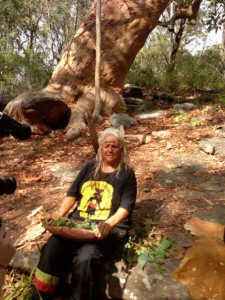 I also remember Auntie Beve recounting stories (told over home-made banana bread) from her time at a bi-racial school. At the time, only part of the school curriculum was offered to the “black kids”, who were asked to leave the room when it was time for the “white kids” to learn mathematics. Instead the Original kids were expected to spend their time “more appropriately” — cleaning the school yard. But a young Beve didn’t accept this way of thinking at all, despite the rampant racism of the day. She would often get up and walk out into the yard with the (other) Original kids in solidarity, or stay and learn the material for the day, then conduct her own class with the Original kids after school, passing on what she had learnt.
I also remember Auntie Beve recounting stories (told over home-made banana bread) from her time at a bi-racial school. At the time, only part of the school curriculum was offered to the “black kids”, who were asked to leave the room when it was time for the “white kids” to learn mathematics. Instead the Original kids were expected to spend their time “more appropriately” — cleaning the school yard. But a young Beve didn’t accept this way of thinking at all, despite the rampant racism of the day. She would often get up and walk out into the yard with the (other) Original kids in solidarity, or stay and learn the material for the day, then conduct her own class with the Original kids after school, passing on what she had learnt.
Auntie Beve once said of her tribal name, Goolabeen, that “the Elders gave me this name long before I ever became a teacher”. Clearly, she was already a teacher – a natural born teacher – well before the Elders even gave her a name. And like I said, one of the things Auntie Beve taught was to always fight for what is right.
Historical Context
Before I talk a little about what Auntie Beve considered “right”, and what she fought for, I’d like to provide some historical context that is often glossed over in this country.
Auntie Beve was the last fully-initiated woman Elder of the Darkinoong, the traditional custodians of the region of Australia’s south east. For the past several hundred thousand years – arguably longer – her ancestors walked, hunted and gathered, raised families, sang and danced, and performed sacred ceremony on this ancient country. They lived in total balance with nature, taking no more than nature offered and giving back what was required in return. In sustainable accord with the spiritual and interconnected essence of human Beings, they honoured the sacred mutual relationship we share with each other and our life-giving Earth Mother, and survived longer and stronger than any living civilization on the planet.
… until white fellas showed up. Over the past 230 years, continued western settlement and the disposable imbalanced culture it embodies has decimated the Darkinoong, along with countless other Original tribes across the Australian continent. The invading British unlawfully disregarded the Original peoples’ sovereign and universal rights, systematically tried to “assimilate” their blood-line out, and tore apart their ancient culture. The natives were dispossessed of their ancestral land, herded into settlements, treated as slaves, separated and forced into “white families” and “white ways”, and robbed of their languages in the process.
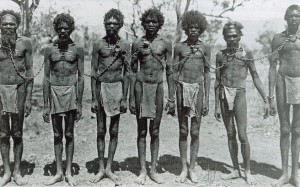 Most Australians incorrectly assume such treatment is a part of our dark and distant past, but in reality, little has changed today. The Original people were classified by their European invaders as “fauna” until 1967 – less than 50 years ago – when the Act that stated “In reckoning the numbers of the people of the Commonwealth… aboriginal natives shall not be counted” was unceremoniously overturned. In the past decade, countless Aboriginal communities have been put under martial law, or what the government refers to as “intervention” (ironically, the government justify their “interventions” by citing problems like high rates of drug and alcohol abuse, problems that didn’t exist until post-British settlement). And still today, despite Prime Minister Kevin Rudd’s historic “apology” to the Aboriginal people, little has changed; Originals (and men in particular) are dramatically overrepresented in prisons and suicide statistics, and massively unrepresented in most other areas of society – including decision making.
Most Australians incorrectly assume such treatment is a part of our dark and distant past, but in reality, little has changed today. The Original people were classified by their European invaders as “fauna” until 1967 – less than 50 years ago – when the Act that stated “In reckoning the numbers of the people of the Commonwealth… aboriginal natives shall not be counted” was unceremoniously overturned. In the past decade, countless Aboriginal communities have been put under martial law, or what the government refers to as “intervention” (ironically, the government justify their “interventions” by citing problems like high rates of drug and alcohol abuse, problems that didn’t exist until post-British settlement). And still today, despite Prime Minister Kevin Rudd’s historic “apology” to the Aboriginal people, little has changed; Originals (and men in particular) are dramatically overrepresented in prisons and suicide statistics, and massively unrepresented in most other areas of society – including decision making.
It is no accident that Original people are statistically “underprivileged” in this country; it was the intent of the early government of the Commonwealth of Australia to marginalize the traditional Original people and assimilate them into “white society”, and after two centuries of systemic abuse, the Australian Government has yet to demonstrate the humble energy and conciliatory spirit required to reconcile this gross affront; this genocide. Although governmental force is less regularly used today, more subtle cultural devices and limitations are used to reinforce negative stereotypes about Original culture and people, thereby encouraging white fellas to accept the social disparity between Originals and non-Originals.
How often in Australia do we still hear offensive stereotypes about the people we collectively disposed? Why are cheesy white fellas like the NSW Minister for Aboriginal Affairs Victor Dominello making decisions about the future of Aboriginal people, their land and their culture? Why have we come to consider “successful” Aboriginal people in this country those who go to western universities, who compete in A-list football leagues, or who get to the semi-finals on Australian Idol — not those who embrace their ancient culture, and live a life steeped in the connection, sustainability, simplicity, spirituality, tradition and wisdom of their ancestors?
Something is NOT right here.
By allowing stereotypes, biased governments and images of “assimilated” Originals to steer the discussion of “Aboriginal Affairs”, and failing to understand the culture, history, people, and their divine connection to the land, we undermine the Original peoples and allow the systemic destruction of their culture to continue. The same kind of thinking that got us into this mess is not going to get us out, nor can we expect to be led out by our “honourable” “elected” “leaders”.
The Old Ways are the only New Way forward.
Fighting for What is Right
Thankfully there were Original people like Auntie Beve, who both learned and taught the Old Ways, and refused to let the ancient spirit of the Original people be lost to the aggressive assault of European imperialism. Her dedication and willingness to learn and share her knowledge has ensured her legacy is one of tradition, connection (to earth and each other) and inspiration.
In her last 6 months, Auntie Beve worked tirelessly to preserve the sacred Women’s Fertility Rites site and vital waterways at Calga. The area is threatened by Rocla Materials’ plans to extend their massive sand mine, which was approved by their good mates in the NSW state “government”. And with the legacy of her ancestors motivating her, Auntie Beve worked to defend this site with every bit of energy she could muster. In fact she had already bought a set of industrial strength chains; if push came to shove, she was entirely prepared to chain herself to the sacred site to protect it. (Despite ongoing legal actions, the site is still under threat from commercial development – as at March 2015.)
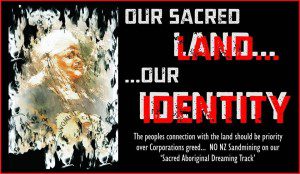 The ancient ceremonial site at Calga is part of the sacred Dreaming track, and has facilitated the cultural and spiritual rites of passage for Original people for millennia – longer than most people can fathom. But the NSW State Government has chosen to overlook all cultural and environmental concerns, of which there are many, and give its full consent to Rocla Materials to bulldoze this ancient ceremonial site and expand its already unsustainable sand-mining operation.
The ancient ceremonial site at Calga is part of the sacred Dreaming track, and has facilitated the cultural and spiritual rites of passage for Original people for millennia – longer than most people can fathom. But the NSW State Government has chosen to overlook all cultural and environmental concerns, of which there are many, and give its full consent to Rocla Materials to bulldoze this ancient ceremonial site and expand its already unsustainable sand-mining operation.
Auntie Beve made it her mission to preserve this important site not just because of its sacred Original significance; Auntie Beve was as pragmatic as she was connected to her Original roots. The waterways at risk are vital to the survival of this region, and are already under unacceptable pressure from the water demands existing mine. According to local experts, the expansion of this site will devastate the local ecosystem, causing up to 30 species to become extinct, including the native Quoll (after which the protest group’s camp site is named).
What’s more, Auntie Beve hated the kind of crony-ism and corruption that evidently created this situation in the first place. She was guided by a sense of right and wrong, and never hesitated to take action when she saw a chance to make a positive change, correct an injustice, or help someone in need. She was an honourable leader; a true Elder.
The Legacy of Goolabeen
Known as ‘Auntie’ to countless people, both black fellas and white, Auntie Beve took her role as an initiated Elder extremely seriously. She could recount the Old stories verbatim, just as she was taught them, time after time. She was an important supporter and mentor to the Aboriginal inmates she worked with the in the NSW prison system, providing them with a sense of cultural identity. The inmates treated her with the same love and respect with which she treated them; ingredients she always maintained was missing in most inmates’ outside lives. She regarded her job as “to love ’em, never judge ’em. They just need to be loved”, and the loyalty they showed her in difficult times (once threatening to riot on her behalf) was a real testament to her strength of character and warmth of heart.
Continuing her work bridging the cultural gap, Auntie Beve recently began conducting Aboriginal education sessions in schools, teaching kids Original history, culture, survival, and crafts. Her classes were designed to teach kids “how the first Australians lived and survived in this great southern land of ours, both in the bush and by the water”. She inspired kids with genuine Original artefacts, and taught them “how to identify, harvest and prepare bush foods and medicines from the leaves, bark and saps of the trees that grow among the great sandstone ridges, rivers and waterholes of this amazing country”.
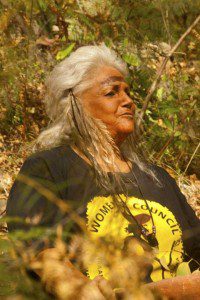
Auntie Beve was also a valued advisor to the Forgotten Origins archaeology crew, and shared her ancient knowledge with our research team for the past 3 years. If it wasn’t for Auntie Beve, our team would no doubt be looking at certain carvings upside down! (I can still hear her saying “You’re looking at it wrong!”) Her understanding of Original culture ensured we were able to interpret and better understand the context of many of the ancient Original carvings, artworks and scripts found in the Bambara/Kariong region, and helped us to continue public discussion of the sacred importance of the area.
But most importantly, she was an innovator, a voice of reason. She saw beyond age, beyond cultures, beyond tribal differences, beyond black and white. She truly embodied the spirit of Wirritjin – the Black Fella White Fella Dreaming. She saw the bigger picture of humanity, and understood that the only way forward is through oneness, not separation. She embodied the ideal of blacks and white standing together, united, and reclaiming our land, our sovereignty and our Universal rights.
Auntie Beve possessed a unique heart and a unique perspective. She proved that genuine understanding between cultures is possible, if we are prepared to stop, look and listen. But as the sun sets on the long ceremonial history of the Darkinoong, I stand on this land reminded that we still have much work to do. In Auntie Beve’s own words:
There is much more to do and learn, so fill your life with positivity and keep pushing forward, learning and teaching. And never say ‘I can’t’ because some way ‘you can and will’ .
This week we lost a good friend and a remarkable character. Although she has rejoined her ancestors, her legacy of “pushing forward, learning and teaching” will continue here in those she inspired.
Thank you Auntie Beve, “the brightest star in the sky”.
Protect the Sacred Women’s Site
The best way I can think of to honour Auntie Beve’s memory is to continue her unfinished work — and the most pressing issue in her heart was to preserve the sacred Women’s Fertility Rites site and surrounding waterways at Calga.
In honour of Goolabeen and the traditional custodians of this land – the Darkinoong – we can and we will.
For more information, please check out:
- Auntie Beve’s open letter about the Calga mining proposal
- Environmental expert Ian Sutton’s assessment of the proposal
To show your support:
- Visit Camp Quoll, the community group defending the site and show them your support and encouragement!
- Follow the Camp Quoll Community Action Group on Facebook
- Write to your NSW State MP
As the Elders said…
It is time for us to unite, join together and walk as one, to protect what is left of this land’s ancient and irreplaceable stories, history and songlines. The Women’s Sacred Site and the ongoing destruction of the Aquifier and Hanging Swamps at Calga, is significant not only to Aboriginal women but to all human kind.
About the Author
I’m just an average 40-something from Melbourne Australia who, like many people, “woke up” and realized everything isn’t what it seems. Since then, I’ve been blessed to be a part of Wake Up World and its amazing community of readers.

If you've ever found value in our articles, we'd greatly appreciate your support by purchasing Mindful Meditation Techniques for Kids - A Practical Guide for Adults to Empower Kids with the Gift of Inner Peace and Resilience for Life.
In the spirit of mindfulness, we encourage you to choose the paperback version. Delve into its pages away from screen glare and notifications, allowing yourself to fully immerse in the transformative practices within. The physical book enriches the learning process and serves as a tangible commitment to mindfulness, easily shared among family and friends.
Over the past few years, Wake Up World has faced significant online censorship, impacting our financial ability to stay online. Instead of soliciting donations, we're exploring win-win solutions with our readers to remain financially viable. Moving into book publishing, we hope to secure ongoing funds to continue our mission. With over 8,500 articles published in the past 13 years, we are committed to keeping our content free and accessible to everyone, without resorting to a paywall.

